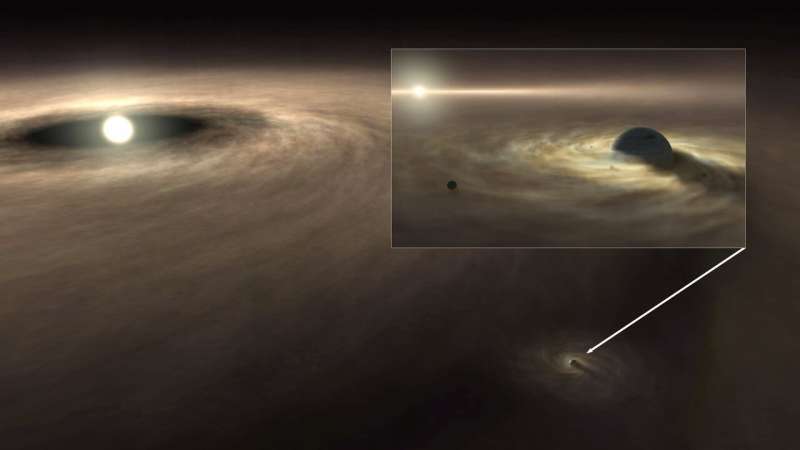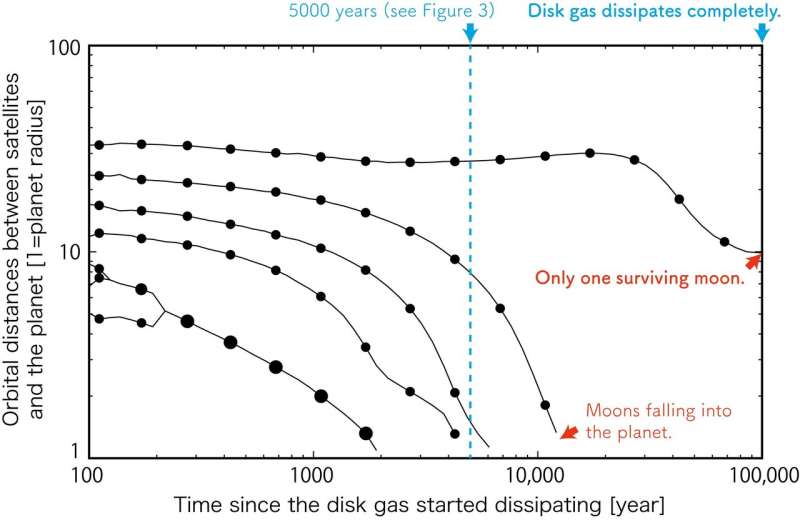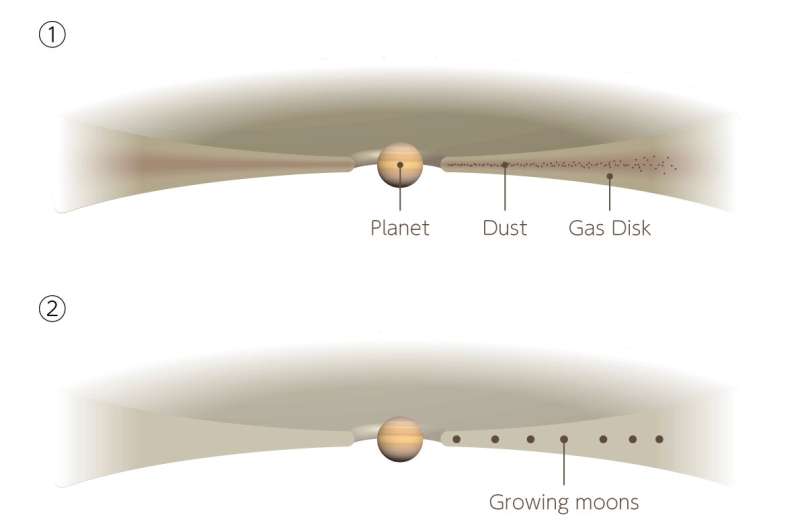An artist’s impression of a satellite forming around a giant gas planet which is itself still forming around a star. Credit: Nagoya University
Numerical simulations show that the temperature gradient in the gas disk around a young gas giant planet could play a critical role in the development of a satellite system dominated by a single large moon, similar to Titan in the Saturn system. Researchers found that dust in the circumplanetary disk can create a "safety zone" that keeps the moon from falling into the planet as the system evolves.
Astronomers believe that many of the moons we see in the solar system, especially large moons, formed along with the parent planet. In this scenario, moons form from the gas and dust spinning around the still forming planet. But previous simulations have resulted in either all large moons falling into the planet and being swallowed up, or multiple large moons remaining. The situation observed around Saturn, with many small moons but only one large moon, does not fit in either of these models.
Yuri Fujii, a designated assistant professor at Nagoya University, and Masahiro Ogihara, a project assistant professor at the National Astronomical Observatory of Japan (NAOJ), created a new model of circumplanetary disks with a more realistic temperature distribution by considering multiple sources of opacities, including dust and ice. Then they simulated the orbital migration of moons, taking into consideration factors including pressure from disk gas and the gravity of other satellites.
Their simulations show that there is a "safety zone" where a moon is pushed away from the planet. In this area, warmer gas inside the orbit pushes the satellite outward and prevents it from falling into the planet.
-
Simulation results showing the orbital radii vs. time of 7 hypothetical moons with Titan mass. As the simulation progresses, almost all of these satellites fall into the planet, however, the outermost satellite alone survives until the disk gas dissipates. This satellite temporarily resides in the “safety zone.” Credit: Fujii & Ogihara, A&A, 2020
-
A scenario for the formation of a single large moon. (1) As a planet forms, a disk containing gas and dust rotates around the planet. Solid materials condense in this disk. (2) Solid components grow to the size of the satellite in the circumplanetary disk. The simulations in this research started from this stage. (3) The orbits of these satellites in the disk change gradually due to the influence of the gas. Many satellites approach the planet while orbiting, and eventually fall into the planet. However, a satellite with an orbit located in a “safety zone” does not fall into the planet, but maintains its distance from the planet. (4) As the gas in the disk dissipates, the satellite which survives in the “safety zone” will remain until the end with a stable orbit. Credit: NAOJ
"We demonstrated for the first time that a system with only one large moon around a giant planet can form," says Fujii. "This is an important milestone to understand the origin of Titan."
Simulation results of the migration map for a disk. The direction of the migration is inward/outward in the blue/red regions. (Video) Black points represent the satellites. All but one of these satellites move toward the planet and fall into it. The outermost object moves to a red “safety zone” allowing it to survive until the disk gas dissipates. You can see that the positions of the “safety zones” change over time. Credit: Fujii & Ogihara, A&A, 2020
However, Ogihara says, "It would be difficult to examine whether Titan actually experienced this process. Our scenario could be verified through research of satellites around extrasolar planets. If many single-exomoon systems are found, the formation mechanisms of such systems will become a red-hot issue."
The study, titled "Formation of single-moon systems around gas giants," was published in Astronomy and Astrophysics in March 2020. The simulations in this research used the PC Cluster operated by NAOJ.
More information: Y. I. Fujii et al, Formation of single-moon systems around gas giants, Astronomy & Astrophysics (2020). DOI: 10.1051/0004-6361/201937192
Journal information: Astronomy & Astrophysics
Provided by National Institutes of Natural Sciences


























